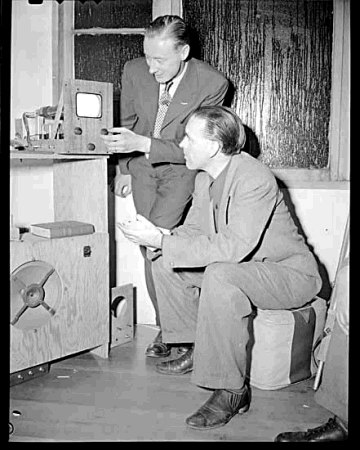EVENT

Television Comes to the West Coast
November 28, 1948—EVENT TYPE Canadian History
VENUES CBC Vancouver | Penthouse, the
On November 28, 1948, nine viewers who were gathered at the home of E.A. Mullins in West Vancouver's British Properties became the first Vancouverites to experience the magic of television. They were able to watch a telecast of a Seattle high school football game on a set that Mullins had built himself using a $238 kit. Over the next few years, television spread quickly throughout the Lower Mainland, with residents using aerials or "rabbit-ears" to tune in to U.S. stations. By the end of 1953, following the establishment of CBC Vancouver affiliate station CBUT, the tens of thousands of Vancouverites buying sets (at a cost of $500) were also able to access Canadian programming. The rampant popularity of the new technology was discussed in the Province, which reported that "Housewives claimed TV paid for itself in money no longer dribbled away on outside entertainment, that it quieted their nerves, kept their families together, and their children off the streets" (qtd. in Bacchus 427).
The new concept of home entertainment meant decreased patronage and sales for local club owners. Ross Filippone, whose family owned the Penthouse Cabaret, notes, "Television hurt the nightclubs. People sat in their living room and turned on the tube. They saw Ed Sullivan with all the name acts you could possibly mention, all in one hour! Four or five top-name acts in the business. And it didn't cost. So people stayed home...they didn't want to pay $1.75 for a drink" (Ross 7).
Although television did mean competition for established forms of live entertainment, it also provided new performance opportunities for local artists. Bamboula, a three episode CBC series broadcast in 1954 and the first musical variety-show on the West Coast, featured Vancouver performers Len Gibson, Thelma Gibson-Towns and Eleanor Collins, who later went on to have her own weekly show on CBC. One of the first TV shows with an interracial cast, Bamboula came to be known as a "vanguard of social change" (Collins), demonstrating how the participation of Vancouver artists in television helped push the boundaries of this new media genre.
The new concept of home entertainment meant decreased patronage and sales for local club owners. Ross Filippone, whose family owned the Penthouse Cabaret, notes, "Television hurt the nightclubs. People sat in their living room and turned on the tube. They saw Ed Sullivan with all the name acts you could possibly mention, all in one hour! Four or five top-name acts in the business. And it didn't cost. So people stayed home...they didn't want to pay $1.75 for a drink" (Ross 7).
Although television did mean competition for established forms of live entertainment, it also provided new performance opportunities for local artists. Bamboula, a three episode CBC series broadcast in 1954 and the first musical variety-show on the West Coast, featured Vancouver performers Len Gibson, Thelma Gibson-Towns and Eleanor Collins, who later went on to have her own weekly show on CBC. One of the first TV shows with an interracial cast, Bamboula came to be known as a "vanguard of social change" (Collins), demonstrating how the participation of Vancouver artists in television helped push the boundaries of this new media genre.
PHOTO GALLERY
Click on thumbnail for larger image

BIBLIOGRAPHY
Bacchus, Lee. "Television." The Greater Vancouver Book. Ed. Chuck Davis. Surrey: Linkman Press, 1997. 427-428.Collins, Eleanor. Personal Interview with Colleen Savage. Vancouver, BC. 2 Nov. 2005.
Montague, Tony. "Blues Salutes Historic Black Community." Georgia Straight, 19 Oct 2006. Online Archive. 3 Jan 2008. http://www.straight.com/blues-salutes-historic-black-community
Ross, Becki. "Men Behind the Marquee: Greasing the Wheels of Vansterdam's Professional Striptease Scene, 1950-75." The Striptease Project. 2008. http://www.arts.ubc.ca/index.php?id=467&backPID=479&tt_news=21








